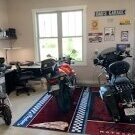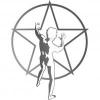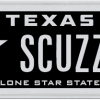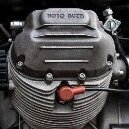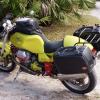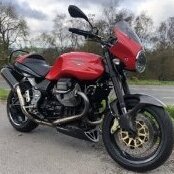-
Posts
2,838 -
Joined
-
Last visited
-
Days Won
48
GuzziMoto last won the day on June 27 2024
GuzziMoto had the most liked content!
Profile Information
-
Location
The skinny part of Maryland
-
My bike(s)
'07 Griso, '01 V11 Sport, '93 Daytona 4v, '87 650 Lario, Aprilia RXV550 Roadracer project
Recent Profile Visitors
4,719 profile views
GuzziMoto's Achievements
-
It is also the tires. Both MotoGP and WSBK use a single brand spec tire. WSBK uses Pirelli and MotoGP uses Michelin. THe Pirelli's in WSBK seem to suit a wider range of bike designs. While a number of bike designs struggle with the Michelins in MotoGP. KTM has issues with the rear Michelin chattering bad. Aprilia also have issues at some tracks getting the Michelin tires to work right. Whereas Ducati seem to have the best handle on the Michelin tires. So they have an advantage. When KTM had the tires figured out a while back, Michelin changed the tires and KTM was struggling again. Other brands also tend to struggle with getting the spec tires to work. I get that part of racing would be getting the tires to work, but it seems much harder to get the Michelins to work in MotoGP then it is getting the Pirellis to work in WSBK. And then you have the goal post being moved, Michelin brining out a new tire construction and / or compound. Ditching the aero should be done, but so far they have no plans to do so, only to reduce / limit the aero. It is in the plans to get rid of the ride height adjustment, that will help. But they should be getting rid of the aero. They are also going from 1000's to 850's, that may help but odds are it will hurt more then help. When they ran 850's before it put more emphasis on cornering speed, so the racing was more processional. If you tried to pass someone you gave up your momentum and they just went back by. So instead you followed, hoping they made a mistake. And the end result was speeds were as high down the straights but higher in the corners, where they tend to crash. So the danger wasn't reduced by the smaller engines, which was supposed to be the point. Odds are at least one brand will get the smaller displacement combo right and the others will once again have to catch up, as happened last time they switched to smaller displacement. And the limits on testing slow down catching up. Currently Yamaha and Honda have help there, they get extra testing and the ability to change things like engines. But Aprilia and KTM don't have those concessions. They are struggling to catch up that last bit to Ducati. Moving to a spec ECU with limited traction control was a great step towards equalizing the racing. The one team that missed that was Yamaha, who didn't hire Weber/Marelli people to help them work out how to use the limited capability of the spec ECU. So even today Yamaha struggle with getting the power down. It makes it look like Yamaha are way down on power, and they are down on power. But they also struggle to put what power they do have down. Their only ace in the hole is Fabio is really good at making the most of the Yamaha and what it does do well. But their issue isn't just needing more power, they also need to be able to put that power to the pavement. Honda also lack power, and they also lack traction. But their traction issues seems to be more an issue with mechanical grip, not their traction control. As with most complex equations, there is usually more then one factor in why any team / bike is slow. Adding more power without the ability to use that power may actually make you slower.
-
I am pretty sure that some bars are the larger diameter. For example, the stock handlebars for a Ballabio are the larger size.. I fact, you can buy the Ballabio bar risers and handlebars and install them on a V11 Sport that came with clipons from the factory. On the wifes V11 Sport that is what we did. The stock top triple clamp even had the boss in the casting for where you would drill the hole for the handlebar clamps. I just drilled the holes for the clamps, and installed. There are lots of options for the larger size bars out there. Most of them (if not all of them) are larger in diameter where they attach to the triple clamp but neck down where the grips and brake / clutch lever attach. I do agree that the higher the handlebars the less direct the steering feels. But another large factor in that is width of the handlebars. Usually clip-ons are narrower, and offer less leverage. Side note, as I recall the Ballabio uses rubber inserts where the handlebar clamps mount to the triple clamps. You can do the same when fitting handlebar clamps to a bike that did not originally come that way, or you can solid mount the handlebar clamps to the top triple clamp. That will increase vibration in the handlebars but improve steering feel.
-
Bagnaia is not liking the 2025 Ducati. He seems to have very little faith and feel in the front end. He had similar issues last year, struggling to get the front end to do what he wants / needs. But this year the 2025 bike seems even worse for him. Hopefully he will be able to sort that out. Bagnaia also has issues with the smaller sprint gas tank, and that is making the sprint races worse then the main race. Think back to JLo on the Ducati, he struggled badly until they modified the gas tank (this was before sprints), then with the gas tank sorted he was suddenly fast. At the level they are at, the smallest details can make a lot of difference. Marc seems to have the speed, right up until he looses the front. I would venture that both Marc and Bagnaia lack the right feel in the front, but Marc doesn't care. The upside of that is Marc is faster, the downside is Marc has crashed out of a couple races already, and the season is young. Ducati seem to have issues with the 2025 bike. And they may be relying on Marc to ride around it. But that is a slippery slope, one that can lead to them being back where they used to be. I think at this point a lot of MotoGP fans are rooting for anyone who is not on a Ducati. That is probably not what Ducati want, but it is a direct result of them signing Marc. They really should have let Marc go to KTM or Aprilia, it would have made them look better and be more popular. A Ducati would likely still be winning, but they would be beating the guy who is arguably the fastest guy in MotoGP right now. They may have also avoided the trap they fell into with this years bike had they not had a rider who could ride around the bikes flaws with front end feel. As to Michelin and their developmental front, this is what the release and the articles about it said. https://www.motorsport.com/motogp/news/michelin-decides-against-new-front-tyre-for-2025-motogp-season/10656046/ "Michelin decides against new front tyre for 2025 MotoGP season. After analyzing data from the Misano test, Michelin has decided to postpone the introduction of a new front tyre originally intended for next season. Michelin has backtracked on its plans to introduce a new front tyre in MotoGP next year. Despite receiving a positive reaction from riders at the Misano test, Michelin has taken a conservative strategy and opted against introducing the new compounds in 2025." They don't even mention Dorna when talking about delaying the new front tire. Why they would delay it is likely the same reason they forced these stupid tire pressure rules on MotoGP, "Better safe then sorry". They would rather not take any chances. As mentioned, a spec tire series is a series that the tire manufacturer can only look bad in if tires don't work right or even fail. They will never beat anyone else, but they can beat themselves by having tire issues. So they really don't want tire issues. That would make them look bad. I personally think they look bad with the need for minimum air pressure rules, but clearly they don't agree.
-
I don't see why you think Michelin would need Dorna's approval to not introduce a new front tire. They (Michelin) hold all the cards there. All they have to say is "We are not ready to introduce it" and it does not get introduced. There is no way Dorna is going to try to force Michelin into introducing a tire that Micheling doesn't want to introduce. I get that Michelin doesn't want to introduce it since they have very limited testing of it. But Michelin do not have to prove anything to Dorna. They are the ones supplying the tires, and if they say they are not supplying a new front tire they are not supplying a new front tire. Reports seem to indicate that Michelin has decided not to introduce the tire. If you have reports that put that on Dorna, please share. As to the Vinales incident and his penalty, I don't think anyone is saying that the rules should not be enforced. What many, myself included, are saying is the rule is stupid and should be changed. Many people, including racers, seem to be saying that. But as it stands, what we end up with is a situation where some racers are able to game the system, are able to run front tire pressure that is too low, but get away with it by artificially inflating that tires pressure by running close behind another racer for enough of the race to meet the letter of the rule. While other racers who are perhaps less skilled in such things, are given a penalty. Vinales's main issue, as you mention, is he ran better then he and the team expected. For that his race was ruined. That doesn't seem right. But, as mentioned before, my main issue with the front tire pressure rule is that Michelin are saying that you can't run the tire below a certain pressure for safety reason, but have no evidence of safety issues below that pressure. On the other side of that coin is that the tire works best below that minimum pressure they set. So, no tire failures have occurred from running below that minimum pressure AND best tire performance is achieved running below that minimum pressure. That makes no sense. I am hopeful about the change in tire supplier. And I do see the small reduction in aero along with getting rid of the ride height devices as being a positive step. I see the reduction in engine capacity as a step in the other direction, that will likely make the racing less entertaining, the same as it did last time. It will likely also increase the danger, as it did last time.
-
Some people like to drive past things, others like to drive through them. I find there is a time and place for each. One of our vehicles is a Jeep, with the top off and doors off you really drive through the world, not past it. Very much like riding a motorcycle, without the need for all the gear. Drop down into a gulch and feel the temp change. Head over a mountain, it changes again. But not everyday, not every trip, is a naked Jeep trip.
-
Two of my favorite two stroke experiences were racing a TZ250, which was a lot like the above mentioned TZ350, and a KTM 440 EXC dirtbike. The TZ250 was the classic two stroke, no power, followed by some power as you rev. Then, around 8,000 rpm it started to make noticeable power. At 10,000 rpm it kicked in and went, pulling hard up to around 13,000 rpm where it was done as quickly as it started. That bike was serious fun on a track. My other favorite two stroke was the exact opposite. The KTM 440 was a monster that didn't have to rev to make power. It was almost friendly at idle, but at some point just above idle it turned into a beast. It quickly went from making some power to making massive power. It was a dirtbike, so it didn't have a tach. But it didn't need one. The power was always there. It was a case of too much power being too much fun. I was not really faster on it then I was on my DR350, but my smile when riding it was way bigger. It would plaster a smile on my face the way it yanked me out of corners. It was like the way spaceships hit warp speed or light speed in sci-fi movies. Expansion chambers can make two strokes deliver amazing power. They don't automatically make for a peaky motor, they don't always means power up top. They can make power wherever they are designed to. Thinking of them as acoustic resonance is a good way to look at them. Depending on how they are designed they can make power down low, in the middle, or up top.
-
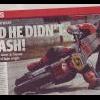
Any reason why rockers would be tight even backed right off?f
GuzziMoto replied to Molly's topic in Technical Topics
The feeling of fresh tires is always nice. The worse the previous tires were the better the new tires feel. I have a few stands, mostly rear wheel stands that lift by the back of the swing arm. Once secured on that stand, getting the front up of the ground on a V11 can typically be done with a jack under the sump. But I make sure the bike is literally tied to the rear stand before doing that. I also have a couple stands that lift the front by the bottom of the forks. I also have a dolly I built with 4 casters and some wood that fits under the sump of a Guzzi. That holds it off the ground and allows me to wheel it around while both wheels are removed. And in extreme cases I have a hoist in the ceiling of my garage that can lift the entire bike off the ground if desired. But that I don't normally do. That is overkill. -
You are free to have that much faith, that much confidence, in Michelin. I do not share your faith and confidence in Michelin. Without even a sign of impending tire failure I don't see a legitimate justification for the current minimum pressure. F1 tires have nothing in common with MotoGP tires. A fundamental issue if you do accept that the minimum pressure limit is justified, is why do their tire perform best at a pressure below what they deem safe. Normally, a tires performance is reduced before it ever gets below what would be considered a safe pressure. For example, when I was racing we would adjust the tire air pressures to get maximum performance out of the tires. At an event down at Roebling Road I mistakenly set the tire air pressure too low. The tires weren't so low they were in danger of failing, but they definitely did not perform well. The tires were sliding around and wearing excessively. That is what you would expect. You would not expect max performance from your tires to occur at a pressure your engineers deem unsafe. I do not except that the minimum pressure rule is justified, but even if you do accept that it makes no sense that the tire works best at a pressure below that supposed safe limit. As to pushing back the introduction of the new front tire, I am not sure that is on Dorna. Michelin announced the push back of the new front tire claiming they needed more testing. Likely that relates to the fact that they can only beat themselves in a spec tire series. The incentive to push the limits is not there. The only incentive to Michelin in a spec tire series is to not screw themselves, to not have tire issues. Introducing a new front tire that turns out is a problem would make Michelin look bad. Not introducing the new front tire until they are sure it is good would make sense. They have nothing to gain by taking a chance. Personally I would rather they roll out development tires alongside the existing tires, allowing riders to choose which tire they want to run. That would also allow them to actually test the new tires under actual race weekend conditions. I think they only have some 30 minutes of actual testing of the new front tire so far. I can see why they are reluctant to commit.
-
As Phil said, those hairs won't cause anything. You may want to adjust the air pressure in the tire(s) that feel "squirmy". I would guess lowering the air pressure would be the way to go, but it could also be you need to raise the air pressure a small amount. If you adjust the air pressure, you would typically do it in small steps, maybe a pound or two (not sure what the Bar equivalent would be, likely a tenth of a bar or two). A good way to tell if your air pressure is right is to measure the tires pressure cold and then ride the bike as normal. Stop the ride and check the air pressure while the tires are "hot". That increase in temp causes an increase in pressure. That increase in pressure should be around 10% - 15%. If the tire pressures don't increase enough, lower the tire pressure. If the pressure increases too much cold to hot, add pressure. It could be the tires simply need to bed in, as mentioned tires generally have mold release to help them come out of the manufacturing molds that give the tires their tread pattern. That mold release tends to be slippery.
-
As mentioned, they do have minimum pressure, in particular (the one that gets all the attention) is the minimum front tire pressure. Michelin set this minimum, in theory, to stop front tire failures that result from running air pressures too low. It must be said, however, that in the era of Michelin being the spec tire supplier there has not been a tire failure from running too low air pressure in the tire. On the other side of that coin, it turns out that best performance of the Michelin front tire occurs at a pressure below the minimum pressure set by Michelin. That makes no sense. Why would you design a tire that performs best at an air pressure you claim is below safety limits? To further complicate things, whether you are running out in front in clean air or behind another racer has a large impact on how hot your front tire gets, and how hot a tire gets directly affects the air pressure inside that tire (as temp goes up, air pressure goes up). So, racers are left trying to guess what front tire air pressure they need to start the race with to keep their front tire pressure above the minimum set by Michelin for at least 60% of the race. It is a balancing act, too much air pressure and they will be slow. Too little air pressure and they will get a penalty. It is not as simple as set it here or above and you are fine, as your front tire pressure will vary depending on whether you are out front or directly behind someone. This was famously shown recently when Marc Marquez pulled over to let his brother by so he could run directly behind him to bring up his front tire pressure. Once he had done enough of the race with his front tire pressure thus elevated, he passed his brother and ran off in front using a tire with air pressure below the minimum value. The rules are so stupid that what Marc did was perfectly legal. Had Vinales paid better attention to his front tire pressure, they typically have a display on their dash telling them what their front tire pressure is and / or whether it is above the minimum value, he may have avoided leading the laps he led to stay in behind Marc to keep his front tire pressure higher. We don't know the details, because they don't tell us things like how low his pressure was and for how much of the race it was. All we know is that his front tire pressure was below the minimum for more then 40% of the race. What was messed up the most was, they should know all this real time, but they only announced the penalty for Vinales around two hours after the race, after he already stood on the podium and got his second place trophy. The rule is stupid, but that was incompetence.
-
It is hard to say what would have happened if Marc wasn't on a factory Ducati. But this is the first race where it may not have been a Ducati winning if Ducati had not signed Marc. Although it could have played out that Vinales won and then had the win taken from him. That would have been seriously cruel. Yes, it was an impressive race from Marc, he had the speed but also the racecraft. However, history is shown that things can change pretty quick, sometimes in a single corner. Vinales has always been a hot or cold racer, some races he shows incredible speed and other races he does not. Sometimes he even shows both in the same race. He really tends to need his ducks to line up to be fast, and he is not that good at lining his ducks up. Look at his results this year prior to this race, 16th, 12th, & 14th. Funny, even though his race was way better this time out after his penalty for the front tire pressure BS he ended up back where he usually is, 14th as I understand it. I would love to see Vinales competitive on a regular basis. But I would not hold my breath. His performance does show that the KTM really isn't that far out, they just need to hit on the right combination of setup. The bike is capable of it, the speed is there. KTM just need to find the right combination of what they have. Currently they are getting that combination wrong, the Michelin tires don't want to work for them (especially the new rear). I have had chatter issue on my front tire, but I have never experienced chatter at the rear. That is bizarre. I hope the coming switch to a different tire manufacturer helps even out the field. The Michelin tire has really become a king maker, with Ducati currently the only manufacturer able to wear that crown. The others are doing what they can with it, but it is always a struggle for them to minimize the issues with the tires. That isn't the best way to have a spec tire series.
-
Well, that was the Marc Marquez of earlier this year, the smarter Marc that doesn't ride beyond his limits to make a point. It wasn't the Marc that we saw at COTA. It was a measured and intelligent ride by Marc to take the win. It was not that from his brother, Alex. Although, to be fair, the contact between Marc and Alex was a racing incident that was mainly Marcs fault. And as I understand it Marc said as much. But the way Alex nailed Digi was brutal. Of course, not as brutal as what happened to Jorge Martin. And then, just to remind us how bad the joke is, a fantastic ride by Vinales was screwed because of a lame rule about tire pressures. That continues to be a bad joke. Vinales was likely robbed of a second place because he managed to get out front in clean air and lead the race for some 5 laps or so. That needs to stop. This is perhaps the first race where Ducati's decision to sign Marc Marquez actually paid off. This is the first race that Ducati might not have won had they not signed Marc.
-
As I recall the motor is offset like 10 mm in the frame to allow for the width of the rear tire. When Guzzi moved to a wider rear tire with the shaft drive setup they moved the entire engine and trans over to make room for the wider wire instead of offsetting the output of the trans so the drive shaft would clear the wider rear tire. It was easier to do that then redesign the trans. This makes the two mufflers a little wonky, as each connects to the motor (the motor that is now 10 mm off to one side) and that means that one head pipe is in front of the other slightly as well as they are both off center side to side. But in my opinion the rear subframe itself should be centered with the chassis spine frame and centered with the rear tire. Just not exactly centered with the exhaust.
-

Any reason why rockers would be tight even backed right off?f
GuzziMoto replied to Molly's topic in Technical Topics
Man, I am too late to this party. But I have to throw in my two cents anyway. My preferred way of choice is to use a straw in the sparkplug hole to find TDC. A straw is rigid enough to feel for the piston but will not hurt anything. And I put the trans in gear and rotate the rear wheel to spin the motor over. That way I never have to worry about whether or not I am rotating the motor in the correct direction. With both plugs out and in a taller gear the motor spins over easy. But to each their own on that. Finally, as have been alluded to, whatever method you are using to find TDC there is always two different TDCs. One where the valves are at overlap and both valves are open and the other where both valves are fully closed. It doesn't matter if you are using the marks on the flywheel, a mark you made on the alternator, an object in the sparkplug hole to find when the piston is at the top of its stroke. There are two different times when the piston is at top dead center, and it will cycle back and forth between TDC with the valves at overlap, then TDC where both valves are closed, then again TDC where both valves are at overlap. If you put it at TDC and the valves do not have clearance, rotate the motor 360 degrees, watching the valves as you rotate. There, I feel better.... -
I won't be surprised at what brand takes pole, I am pretty sure that will be Ducati. But I am way less sure about which rider will be on that pole winning Ducati. There are even more reasons why FP1 was not very meaningful. In addition to the track being dirty and slippery with a distinct lack of grip, FP1 is also held during the day while the sun is up. Where as racing and qualifying will be held after the sun goes down. But FP1 was interesting. One thing was that the top 10 were covered buy 9 thousandths over one second, 1.009 seconds, but the gap between Marc and second fastest was over a half a second (0.513 seconds). Clearly Marc was pushing harder in the slippery conditions then anyone else was willing to push, especially because being fast in those conditions really wasn't going to matter over the course of the weekend. That may bode well for Marc, or it may not. I certainly wouldn't bet against Marc, but I also would not bet on him. It could easily go either way.


